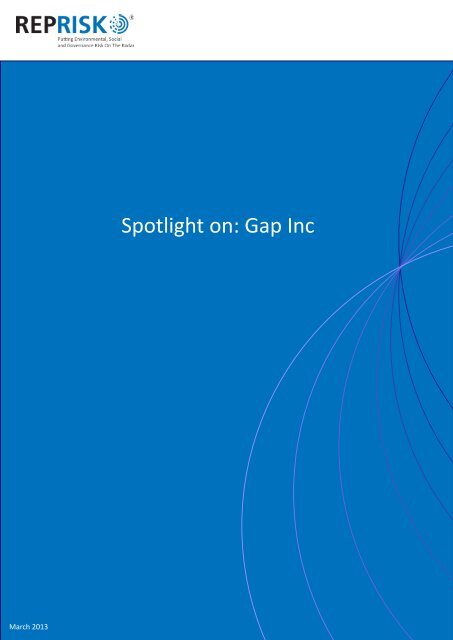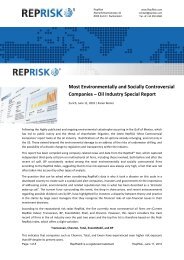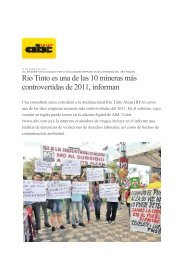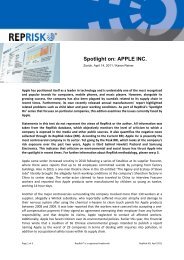Download report - RepRisk
Download report - RepRisk
Download report - RepRisk
Create successful ePaper yourself
Turn your PDF publications into a flip-book with our unique Google optimized e-Paper software.
March 2013<br />
Spotlight on: Gap Inc
Fashion firm, Gap Inc, has long been steeped in controversy due to allegations of social and environmental<br />
wrongdoings within its supply chain. It is not alone in this respect with many of its retail industry peers also<br />
facing ongoing criticism for similar issues. Over the last few years, <strong>RepRisk</strong> has detected numerous NGO<br />
<strong>report</strong>s, media articles and documented campaigns that target garment manufacturers for these issues and lay<br />
blame on the companies sourcing from them. In the past two years, Gap Inc came close to reaching the ‘high<br />
risk’ category according to the <strong>RepRisk</strong> Index, on several occasions.<br />
In late 2012, it eventually attained a score in this realm, indicating recurrent environmental, social and<br />
governance problems. The <strong>RepRisk</strong> database has also captured allegations made against the company by<br />
independent third parties that date back several years prior to this period. Gap has been linked to procurement<br />
controversies in several countries, many of which are considered to have poorly implemented employee health<br />
and safety standards, as well as dubious unionization policies. These include India, Bangladesh, Sri Lanka,<br />
Cambodia, Indonesia, and the Philippines among others. A 2011 <strong>report</strong> by NGO War on Want, entitled ‘Stitched<br />
Up,’ aimed to expose the alleged abuse of female workers’ rights in these Asian countries. It claimed that<br />
exploitation was ongoing despite pledges by western retailers such as Gap, Zara, Primark, and Marks & Spencer<br />
to observe a supplier code of conduct in regard to wages, working hours, and non-abusive environments. The<br />
<strong>report</strong> detailed excessive working hours with compulsory unpaid overtime to meet production targets, beatings<br />
and sexual discrimination by employers, as well as a lack of basic women’s rights including maternity leave and<br />
statutory rest days.<br />
For more information on <strong>RepRisk</strong>’s methodology please see: www.reprisk.com<br />
In the recent past, groups such as Anti-Slavery International and the Centre for Research on Multinational<br />
Corporations (SOMO) have released <strong>report</strong>s naming major retailers, including Gap, which source from textile<br />
manufacturers in India where unmarried women from lower caste families are targeted and forced to work 12<br />
to 16 hours a day in “prison-like” conditions for less than minimum wage. According to activists, this amounts<br />
to bonded labor. In Tamil Nadu state, for example, 200 former employees claimed they were promised lump<br />
sum payments at the end of a three-year contract but did not receive this due to illness or termination of their<br />
agreements. Gap has also been haunted by past accusations. In 2011, a blog addressing sweatshop production<br />
at major retailers referred to older allegations, dating back to 2007, that children as young as eight had<br />
produced garments at a Gap supplier factory in India. Allegedly, the children were sold into this environment to<br />
help support their families, and worked 14-hour days without payment. Gap took immediate action, stating it<br />
had been unaware of the subcontracting, and removed 10,000 items made in this particular factory from sale.<br />
Back in 2010, up to 80,000 Cambodian garment workers were <strong>report</strong>ed to have taken part in demonstrations<br />
for better wages and benefits in the second half of the year. Labor activists targeted Gap, among several other<br />
brands, for failure to put appropriate measures in place at their supplier factories. In the same year it was also<br />
<strong>report</strong>ed that in Cambodia, striking female workers at a factory owned by PCCS, allegedly a Gap supplier, were<br />
beaten by police using tear gas and electric shock batons and forced back to work.<br />
<strong>RepRisk</strong>® is a registered trademark <strong>RepRisk</strong> AG, March 2013 2 of 4
In China, Gap was among a number of clothing retailers linked to environmental violations at supplier facilities<br />
in a <strong>report</strong> entitled ‘Cleaning up the Fashion Industry.’ According to the <strong>report</strong>, the country’s textile industry<br />
produces up to 2.5 billion tons of wastewater and other harmful pollutants every year, most of which end up<br />
in China’s water bodies, soil, and groundwater. In 2011 and 2012, NGOs highlighted serious risks associated<br />
with manufacturing in Bangladesh. The Clean Clothes Campaign <strong>report</strong>ed that Gap, together with H&M, is one<br />
of the largest buyers in the country and must take responsibility for improving the poverty wages. The country<br />
apparently boasts the lowest pay in the world, the weakest regulation, and the worst attention to workplace<br />
safety. This has <strong>report</strong>edly resulted in the death of almost 500 garment factory workers over the past 5 years.<br />
A 2010 fire killed 29 people in a Hameem Group factory supplying to major brands such as Gap. Most of the<br />
victims were women earning less than USD 2 per day.<br />
The tragedy was caused by unsafe conditions at the factory including an electric wiring overload that sparked<br />
the flame and a lack of fire escapes. Managers had allegedly locked the factory doors, meaning the workers<br />
were trapped inside. In December 2011, a boiler explosion at a Eurotex garment factory in Dhaka, which<br />
<strong>report</strong>edly supplies to Gap, resulted in the deaths of two workers and caused severe injuries to a further 62.<br />
Several months later, NGO War on Want <strong>report</strong>ed that Gap would take responsibility for the incident and offer<br />
compensation and treatment to victims and their families.<br />
While international companies have stated their willingness to establish a fire safety program and made some<br />
efforts to do so, the working environment has allegedly not improved. Most recently, Gap was linked to Tazreen<br />
Fashions’ garment factory, where a November 2012 blaze killed at least 111 workers and injured dozens<br />
more. Over the past few years, Gap has also been linked to poor conditions at facilities in Central America. In<br />
Honduras, it was accused of sourcing clothes from ‘maquilas’ – large industrial sweatshops where labor laws<br />
and worker rights are <strong>report</strong>edly often ignored. Factory employees allegedly earn less than a living wage and<br />
are forced to do overtime to make up for the work hours lost due to a government-imposed curfew in the wake<br />
of the 2009 military coup. In El Salvador, a similar situation <strong>report</strong>edly existed at Ocean Sky factories, with<br />
claims that Gap was one of the companies sourcing from them.<br />
In Mexico, the company was named in a Greenpeace <strong>report</strong>, published in late 2012, as one of the international<br />
retailers sourcing from a Kaltex facility, accused of discharging toxic chemicals and wastewater into water<br />
bodies. The NGO urged all companies mentioned to take action to ensure their suppliers do not pollute.<br />
In November 2012, Greenpeace released another <strong>report</strong>, ‘Toxic Threads,’ which accused 20 global brands,<br />
including Gap, M&S, Esprit and Nike, of manufacturing clothing containing toxic chemicals that polluted<br />
waterways and endangered human health, the environment and wildlife.<br />
It appears that the issues<br />
faced by Gap and its peers<br />
in terms of labor rights and<br />
environmental damage<br />
in the companies’ supply<br />
chains are ongoing and<br />
occur on a global scale.<br />
Such issues continue<br />
to plague high-profile<br />
fashion multinationals and<br />
impact negatively on their<br />
reputation. The question<br />
of how risky this is for their<br />
operations with respect to<br />
business continuity, public<br />
backlash, and government<br />
regulation, remains to be<br />
answered.<br />
<strong>RepRisk</strong>® is a registered trademark <strong>RepRisk</strong> AG, March 2013 3 of 4
DISCLAIMER<br />
The information contained in this <strong>report</strong> (“Report”) is not intended to be relied upon as, or to be a substitute<br />
for, specific professional advice. No responsibility for loss occasioned to any persons and legal entities acting on<br />
or refraining from ac¬tion as a result of any material in this publication can be accepted. With respect to any<br />
and all the information contained in this Report (“Information”), <strong>RepRisk</strong> makes no representation or warranty<br />
of any kind, either express or implied, with respect to the Information, the results to be obtained by the use<br />
thereof or any other matter. <strong>RepRisk</strong> merely collects information from public sources and distributes them<br />
in the form of this Report. <strong>RepRisk</strong> expressly disclaims, and the buyer or reader waives, any and all implied<br />
warranties, including, without limitation, warranties of origi¬nality, accuracy, completeness, merchantability,<br />
fitness for a particular purpose and warranties related to possible violations of intellectual property rights,<br />
trademark rights or any other rights of any third party. This <strong>report</strong> may be quoted, used for business purposes<br />
and may be shared with third parties, provided www.reprisk.com is explicitly mentioned as the source.<br />
METHODOLOGY<br />
<strong>RepRisk</strong> special <strong>report</strong>s are compiled using information from the <strong>RepRisk</strong> database, which consists of facts,<br />
criticism and controversies related to projects and companies’ environmental, social and governance<br />
performance. The <strong>RepRisk</strong> data¬base currently contains criticism on more than 30,000 private and publicly<br />
listed companies. <strong>RepRisk</strong> analysts monitor the issues related to environmental, social and governance<br />
risk across a broad shareholder and other stakeholder audience of NGOs, academics, media, politicians,<br />
regulators and communities. Once the negative news has been identified with ad¬vanced search algorithms<br />
and analyzed for its novelty, relevance and severity, risk analysts enter an original summary into the database<br />
and link it to the companies and projects in question. No article is entered twice unless it has been escalated<br />
to a more influential source, contains a significant development, or has not appeared for the past 6 weeks.<br />
This helps to ensure the balanced and objective rating and weighting of the negative news, and thus the<br />
company’s quantitative measure of risk exposure, the <strong>RepRisk</strong> Index (RRI). The RRI measures the risk to a<br />
company’s reputation, not its actual reputation in general. <strong>RepRisk</strong> objectively monitors the level of criticism<br />
to which a company is exposed. All data is collected and processed through a strictly rule-based methodology.<br />
Controversial issues covered include breaches of national or international leg¬islation, controversial products<br />
and services, environmental footprint and climate change, human rights and community relations, labor<br />
conditions and employee relations as well as fraud, anti-competitive behavior tax evasion and corruption. In<br />
particular, all principles of the UN Global Compact are addressed.<br />
ABOUT REPRISK<br />
<strong>RepRisk</strong> is the leading provider of business intelligence on environmental, social and governance (ESG) risks.<br />
It systematically collects and analyzes facts, criticism, and controversies related to companies and projects<br />
worldwide. It does so on a daily basis and in 13 languages from thousands of public sources including<br />
international and local media, government sites, non-governmental organizations (NGOs), newsletters, social<br />
media and blogs. The <strong>RepRisk</strong> database currently includes information on over 30,000 companies, 6,500<br />
projects, 5,000 NGOs and 4,000 governmental bodies. These numbers are continuously growing as relevant<br />
ESG information is added. The use of <strong>RepRisk</strong> business intelligence allows companies and financial institutions<br />
to proactively assess ESG issues that may present financial, reputational and compliance risks. For more<br />
information about the usage and benefits of <strong>RepRisk</strong> in relation to the effective management of ESG Risk,<br />
please visit our website: www.reprisk.com<br />
Contact Information<br />
For more information about the <strong>RepRisk</strong> tool or this Spotlight on Gap Inc Report, please<br />
contact media@reprisk.com or visit our website: www.reprisk.com.<br />
<strong>RepRisk</strong>® is a registered trademark <strong>RepRisk</strong> AG, March 2013 4 of 4











